outcomes of casting nets of bifurcating dynamic tines and trying to hold onto something....on some scale....in some location....for some duration of time (ultimately to be let go...the boundary of holding)
Wednesday, September 29, 2010
Displacement
Every single second we are displacing to somewhere in somehow. My story tells something about that and, of course, starts in an obvious way... me, how did I get here? I would start saying that I toke a plane from Mexico city to -----> Detroit stopping over in Dallas, TX. but this instead of being an answer became a bigger question: what is to displace? and it just goes on...to where did I displace? Since when am I really here? and then the story comes and takes us again to the same point... People displacing, people going from one point to another. My concept is beyond any physical attempt of moving , taking the brain and its functions as a mean of transportation and in fact, I consider that this is the first and most recurrent mean of transportation we all take in first place for most of our activities, besides, who I could say then, in a crazy way, that I have about a year here, when I applied for the scholarship and my mind landed here somewhere, so time becomes relative and exclusive of the instant and the entity: for my mind this can be a fact but for my body it's still a posibility, wich means as a fact that either if going or not the idea itself can take a space in time and cause displacement.
Thursday, September 23, 2010
Gain a little false perspective
It's amazing how powerful the act of obscuring some information can be used to illuminate something specific and to (quite literally in this case) gain a new perspective on something familiar. Depth, clarity and new life added through obfuscation.
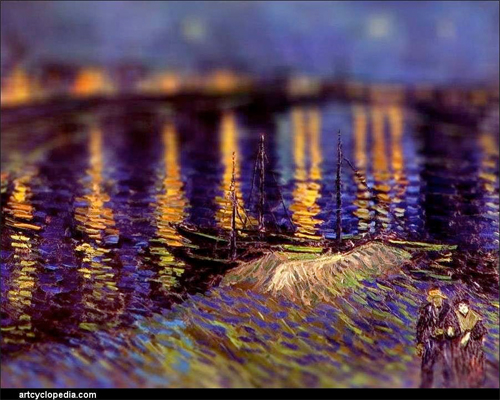
Click image for link to more images. Thanks to Gizmodo for posting this.
Wednesday, September 22, 2010
ONE WORD book video (featuring "fork" from "sixpack")
 The promotional video for One Word book: contemporary writers on the words they love or loathe, edited by Molly McQuade from Sarabande Books features excerpts from fork, a section of the essay sixpack by Thylias Moss, a close associate of forkergirl.
The promotional video for One Word book: contemporary writers on the words they love or loathe, edited by Molly McQuade from Sarabande Books features excerpts from fork, a section of the essay sixpack by Thylias Moss, a close associate of forkergirl. Please enjoy this marvelous multimedia short film by Tucker Capps for Sarabande. Dear Storytellers (as we keep waiting for motion, please note the mix of active and static elements in this little film that delivers forkfuls of visual delight, the quick shift from one visual to another, continuity maintained/sustained by both the spoken text (written by forkergirl's friend) and the music by Jonathan Zalben. Note the range of visual textures. In this case, text preceded the film, inspired the film, provided both rules and obstructions in which/despite which the short film was made. The writing itself did not mandate an unfolding of content as a plot-dependent narrative —indeed; rules embedded in the structure of the writing (structure determined by tenets of Limited Fork Theory) may have made plot-dependent narrative an unlikely vehicle for content intentions or the content transcendence that occurs in this film.
One Word: Contemporary Writers on the Words They Love or Loathe from Sarabande Books on Vimeo.
From the One Word book website:
In One Word: Contemporary Writers on the Words They Love or Loathe, Molly McQuade asks the question all writers love to answer: what one word means the most to you, and why? Writers respond with a wild gallimaufry of their own choosing, from ardor to bitchin’ to themostat to wrong to very. There is corn, not the vegetable but the idea, defining cultural generations; solmizate, meaning to sing an object into place; and delicious slang, such as darb and dassn’t. Composed as expository or lyric essays, zinging one-liners, extended quips, jeremiads, etymological adventures, or fantastic romps, the writings address not only English words but also a select few from French, German, Japanese, Quechua, Basque, Igbo, and others. The result is like the best of meals, filled with color, personality, and pomp. There is something delightful and significant for every reader who picks up this wonderful book.
“This sublime anthology is poetry for people who don’t read poems, collecting 67 essays, short stories, and memoirs in which seasoned writers and novices expound, meditate, or riff on a single word. The words range from the familiar (forget by Mimi Schwartz, crash by Dan Moyer) to the obscure (darb by Erin McGraw [1920s slang for an excellent person or thing], umunnem by Kelechi Okere [an Igbo term for all one's blood relatives], from the short (a by Joel Brouwer takes up eight pages) to the long (floccinaucinihilipification by Siobhan Gordon [it means nothing]. Thylias Moss’s disquisition on fork and related words itself forks in many directions. Jason Iwen detects capitalist ideology in interesting, which first appeared in 1711 in an economic context. Poets are almost half of the contributors, but they also include critics, translators, academics, and novelists. These marvelous little pieces of writing highlight not so much the words themselves as what words do, how they exist as themselves but also as the carriers of meanings, which shift and branch into many paths real and metaphoric, juicy with sound.”
—Publishers Weekly (starred review)
“One Word is a rich and varied collection of meditations on words from the simplest (a and or) to the rarest (kankedort, with only one known occurrence) and from the most basic (doom and filthy) to the most ornately elaborate (floccinaucinihipilification). Starting with Joel Brouwer’s deeply perceptive and thoroughly entertaining exploration of the article a through Lee Martin’s narrative of childhood memories attached to the tricky word colander, Joan Connor’s vignettes associated with lilac, Eric Ormsby’s profile of or (“It’s not a showy word but a worker word, a syntactic functionary. … Or stands like a squat bouncer at the revolving door of the disjunction.”), to Mary Swander’s recounting of two billion years of geological history lying beneath topsoil, we encounter all of the many ways that language and human events intersect. In each case, the writer has chosen, to borrow wording from Maureen N. McLane’s essay on kankedort, an “exceptional word”, an “unusual word,” a word that has “lodged itself like a mystery, a word that gathered around it associations [both] personal and ramifying…” Not surprisingly in a collection of writings about language, we encounter not only discussions of words and meanings but also stories of relationships with parents, children, mates, and friends, and of the intimate and powerful forces that shape lives. It is a measure of the power and the wisdom and the charm of these pieces that a reader’s relationship with these words will never be quite the same after reading this collection. Maggie Hivnor’s words about Yeats’ use of the word half-light seem apt for this collection as well: “When poets use a word as well as that, they leave a trace of meaning on it, a fingerprint—or sheen: a new layer of lacquer, a warmth, like the time-worn glow on the newel-post of an old banister, touched by generations.” Readers of this collection too will find that the words profiled here have a new trace of meaning, a warmth, and a time-worn glow.”
—John Morse, President and Publisher of Merriam-Webster, Inc.
“At last! A dictionary for people who are words! From the eight pages that define “A” (the fifth most commonly used word in English) (“A never looks back”) to the concluding two pages of “Wrong” (“Two wrongs only make a wrong wronger.”), what we have here is a smorgasbord of sentience, a collision of serendipity and scholarship. This is a book at play in the fields of meaning, a sixpack (Thylias Moss) of quipus (Arthur Sze), a dehiscence (Forrest Gander) of florere (Vincent Katz), I (Cynthia Gaver) hope (John Rodriguez) as (we like it) (Brenda Hillman). We like it! When More’s Utopia is realized, One Word will be the vocabulary list for the SATs. (Except: there will be no SATs!)”
—Bob Holman
Tuesday, September 21, 2010
MERMAID AS METAPHOR (a consideration from forkergirl's temporary fish eye lens advantage)
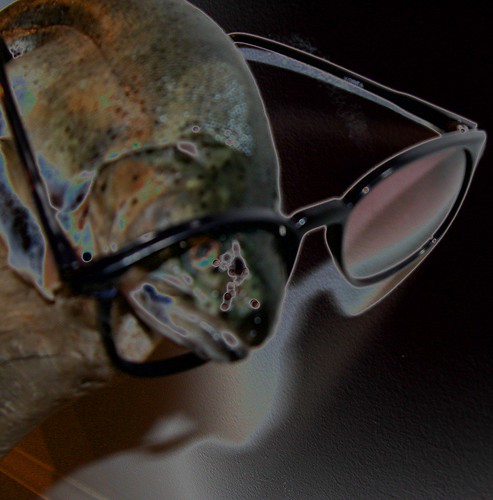 fish eye lens advantage image from forkergirl's photostream
fish eye lens advantage image from forkergirl's photostreamIn this consideration of Mermaid as Metaphor, a point of entry and a point of departure (bifurcation hub) are formed by two elements brought together (in a range of manipulations) forming a third element that is a composite of the two (1 element plus 1 element = a 3rd element [1+1=3], as Rima pointed out in a limited forked multimedia story class). At this hub is a common depiction of mermaids in which two unrelated biological segments of two organisms are brought together in (primarily visual) unification usually depicted as horizontally split halves forming wholeness: a mermaid.
This (visual) wholeness is a form of marriage, an easily imagined evolutionary progression or regression of marriage. Though the one mermaid outcome of wholeness formation is usually offered, there are at least two composites that would emerge from each union in this imagined evolution or regression. Human upper body + fish lower body, and human lower body + fish upper body. This is an answer to where's the other halves? —the human lower body and the fish upper body? An example of this more complete merger outcome scenario supplies the horror factor of The Fly (1958). The human/fly hybrid is created when a teleportation experiment meant to be an exclusively human teleportation experiment becomes a human/insect teleportation experiment when a fly is discovered inside the teleportation chamber with the scientist when the experiment is already underway and no one is there to stop the experiment. Though the human/fly hybrid is an unintended outcome, that the hybrid is an outcome indicates a form of successful, if horrifying, biological union. The film features both composite forms: human body with fly head/hand and fly body with human head/hand. Once the hybrids emerged, the assumption was that capturing the fly body/human head composite and repeating the experiment with both hybrid outcomes in the chamber, would restore the human and the fly to pre-composite forms though other possibilities would have been as likely had the fly body/human head variation not been snared in a web of spider for whom the genetic modifications of the humanized insect changed nothing.
Though I hesitate the use the term, this serves, in part, as a, well, deconstruction of the mermaid metaphor. It is a closer look inside what is and isn't occurring in the architecture of the metaphor that a mermaid is, and simultaneously is an invitation to explore what can happen/is happening inside other metaphors, using the outcomes of those explorations to establish other opportunities and forms of expression: the making of other poams (products of acts of making).
In popular depictions of mermaids, biological segments contributed by the human and by the (unspecified species of) fish seem interchangeable, largely because each segment apparently remains intact with crossover of fish into human, human into fish. The fish and human portions of a mermaid hybrid system could be separated easily. It is obvious where to cut. The human and fish segments seem closed systems stitched together (or in some other way held in place) superficially. The forming of human/fish composites seems exceedingly neat with a well-defined boundary separating fish function and appearance from human function and appearance. No transgression of species apparently occurs; nothing, well, fishy in the merger. Mermaids, rather, seem models of respect for species purity despite their being linked. No tinkering with the actual DNA as human DNA and fish genetic code don't mix, but instead exist side-by side. Good neighbors who share much, but not everything. Good spouses who share much but not everything.
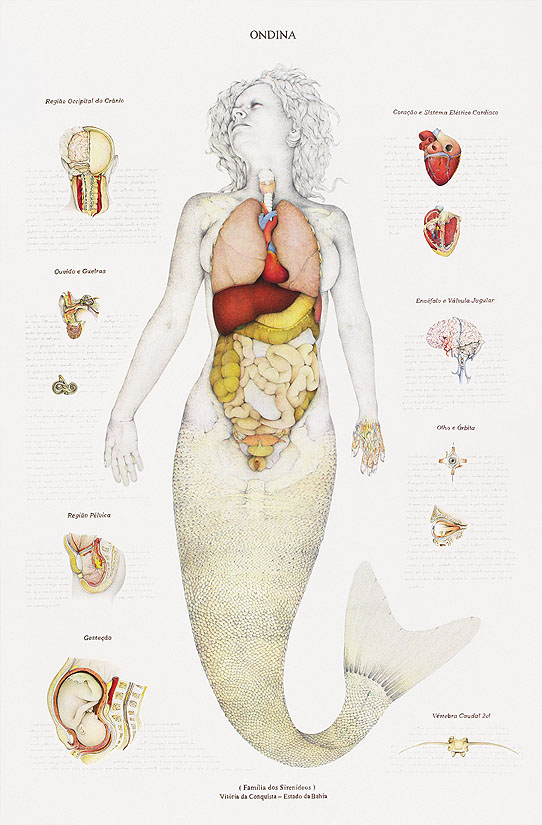 If a deeper connection is considered, the external division and separation of fish and human raises questions about function, form, and layout of internal organs. Just how is the mermaid metaphor creature mapped internally? Surely anatomical mingling occurs, or it is difficult to imagine viability of this trans-species as a species distinct from human and fish with its own biological frameworks and systems; the fish, in the more frequent ichthyological bottom half mermaid configuration, would have no heart, no brain, no circulation of human blood in fish areas. If the halves are stitched together superficially and not integrated into a single being, each half would then need separate and contained systems of respiration, systems of ingestion, systems of excretion, etc. A romanticized depiction (and why not such a depiction!) of mermaids does not support contamination of the beautiful, usually, woman, with fishiness. Indeed, the mermaid might even be a purer form of woman for rejecting genitalia in favor of fishtail; with breasts, she may suckle a child and could even seem, depending on who's constructing the idea system, nearly as wholesome and good as Mary, Mother of Christ. In this wonderful anatomical chart (to the right) of a mermaid from gearfuse.com, the internal revelation is still decidedly human in keeping with the biological structure of most mermaids; no doubt a common or typical mermaid is dissected in the well-imagined image of mermaid reality wherever it exists, in imagination, gaming, and/or virtual worlds, for instance. Mermaid Diaries is a blog all about a little mermaid named Natalia Zelmanov and her adventures in second life. Below is a video of a Spore mermaid followed by a video of a Second Life mermaid show:
If a deeper connection is considered, the external division and separation of fish and human raises questions about function, form, and layout of internal organs. Just how is the mermaid metaphor creature mapped internally? Surely anatomical mingling occurs, or it is difficult to imagine viability of this trans-species as a species distinct from human and fish with its own biological frameworks and systems; the fish, in the more frequent ichthyological bottom half mermaid configuration, would have no heart, no brain, no circulation of human blood in fish areas. If the halves are stitched together superficially and not integrated into a single being, each half would then need separate and contained systems of respiration, systems of ingestion, systems of excretion, etc. A romanticized depiction (and why not such a depiction!) of mermaids does not support contamination of the beautiful, usually, woman, with fishiness. Indeed, the mermaid might even be a purer form of woman for rejecting genitalia in favor of fishtail; with breasts, she may suckle a child and could even seem, depending on who's constructing the idea system, nearly as wholesome and good as Mary, Mother of Christ. In this wonderful anatomical chart (to the right) of a mermaid from gearfuse.com, the internal revelation is still decidedly human in keeping with the biological structure of most mermaids; no doubt a common or typical mermaid is dissected in the well-imagined image of mermaid reality wherever it exists, in imagination, gaming, and/or virtual worlds, for instance. Mermaid Diaries is a blog all about a little mermaid named Natalia Zelmanov and her adventures in second life. Below is a video of a Spore mermaid followed by a video of a Second Life mermaid show:and, in keeping with her fish contribution, is an excellent catch.
Consideration of shared biological functioning is not meant to discredit the mythic or aesthetic function of mermaid systems, and certainly does not undermine an ability of imagination to overcome problems of mermaid existence within shared physical realities. That closed biological and chemical systems can align themselves without sharing structures or circulation, may give a nod to some of the power of imagination as part of the glue maintaining the human/fish alignment. Not that everyone can (or should) use imagination in tis manner; what I refer to as imagination may be referred to differently in other cultural and/or belief systems that configure reality differently, including religions in which what some might consider supernatural is real; prayer connects a human mortal reality with a divine system of existence; prayer and belief function as bridges between these configurations.
It is quite odd, I think, that more mingling apparently does not occur at the juncture of fish and human in a mermaid system of co-dependency to be one being, one creature; why not more raggedness as these halves struggle to come together? In the production of mermaids, if something is occurring biologically, why not more evidence of mutation in the manipulation of humans and fish to produce mermaids? Where are the failures? Where are the monsters of human/fish alliances? Where are the other creature from black lagoons (gill-men) and other evolutionary missing links along the evolutionary road to mermaid? What is it about certain environments that seem to encourage emergence of human/fish hybrids? So much perfection! —similar, it seems (sorry for a lack of statistics) to a rate of perfection in production of angels or other beings embodying some human elements and some divine elements. Something in imagination apparently overcomes potential conflict in human and fish unions —did not George W. Bush say that he hoped the human and the fish could coexist peacefully? In configuring scenarios of this coexistence, some of that peaceful cohabitation would exist within a single body, half human, half fish; the bi-species creature practicing a form of political correctness in blending —indeed, Bush's statement could be construed as a call for transspecies experimentation, phase one focusing on human and fish peacful coexistence scenarios.
Had W seen Shiloh Pepin on a Discovery Channel documentary (Mermaid Girl) when he said that?
Did he realize that there was such a condition as sirenomelia, that humans were sometimes born with their legs fused in a disease commonly called mermaid syndrome, a challenging coexistence that might look peaceful? What hope for the future of humans did he foresee in improving human/fish coexistence? What's in that enhanced coexistence for Americans? for democracy? for capitalism?
In written metaphor also things come together with suspicious ease, perhaps in part because of familiarity with a long history of mythical part human creatures from ancient, classical, and sacred texts ; indeed, even Jesus Christ is a half-human outcome of a human/divine union. Evolutions occur inside metaphor; there is a journey from something to something, and details of the journey are seldom mapped. Mapping of what occurs inside metaphor could be quite revelatory and could lead to other revelatory forms of making, thinking, and/or understanding. To the left, Gort becomes The Stig, and to the right, Sambo becomes Obama in two metaphork evolutions by forkergirl. Much, much (compelling and exciting, among other forms of work) remains to be done.
Labels:
anatomy,
Bushism,
composite,
deconstruction,
evolution,
forkergirl,
Gort,
hybrid,
imagination,
limited fork,
marriage,
mermaid,
metaphor,
Obama,
Sambo,
second life,
Shiloh,
spore,
Stig,
The Fly
Monday, September 20, 2010
Fractal Sound
The concept of fractals (mathematical structures that sometimes pop up in nature that are self-similar, which is to say if you look at them on any scale they will tend to roughly look the same, often constructed by taking a pattern, replacing each element with the original pattern, then replacing the tiny elements of those smaller patterns with the whole pattern, etc etc etc) has occasionally been applied to music but almost always through generating non-random sequences of notes or attempting to play the pictures fractals generate through various sonification techniques.
However, sound is just periodic variations in pressure. Music is organized sound, or to state it with consistent terminology, patterned variations of periodic variations in pressure. Timbre can also be said to be periodic variations the pitch of a sound (but at audio rates if you want to generate all possible timbres, otherwise known as FM synthesis), with the pitch of a sound being the rate at which it's varying.
So, it should be possible to create fractal Music, which is not only self-similar in it's structure of notes, but down to the timbre from note to note. By using self-similar patterns across all scales of time the waveforms will resemble the phrases will resemble the entirety of the piece. Variation could be made by varying the rules. You could also apply a different kind of rule (like variations in pressure or harmonic content rather than pitch).
Given a certain kind of rule or a rule with significant complexity the self-similarity could be obscured a bit, making it seem more organic or human. Another possibility to add richness would be to add chaos. Human input could alter the rules or jar the results in unpredictable ways. Sensor based input or semi-random systems could fight with the fractal patterns in an endless and varying battle between order and chaos, noise and music.
Whether the aesthetics are better when the system tends towards regularity, unity or chaos and where the balance is remains to be heard.
Also what all this would sound like remains unknown, at least until my programing work progresses more.
Thursday, September 16, 2010
Multicultural Stories
I have been interviewing people from all over the world (Brazil, Kazakhstan, Australia, India, France Germany, Italy, England, Thailand, Iran and USA) to uncover their stories and how they came to live together in Michigan. I have found some fascinating cultural differences between their countries and America... how quiet it is compared to India; how my friends from Kazakhstan miss eating horse meat; in Thailand you must take your shoes off to go inside; in Brazil everyone goes home at lunchtime to eat with the family; and the English use ridiculous words like nappy and hoover!
A Different Kind of Story
Dentsu London created an amazing project using 3D modeling, photography, and an iPad. The video does a better job explaining the project than I can with words, but it's an interesting way to tell a story using LCD screens as a medium to paint light into real spaces. Check it out:
Making Future Magic: iPad light painting from Dentsu London on Vimeo.
MERMAID PRELUDE to: Mapping of Rules & Obstructions in Limited Fork Theory Stories
Once I decided on Mermaid, Mermaid became a rule, was being included according to a logic of inclusion. Mermaid is with me now. The context of sharing, in part an attempt to finagle inclusion of mermaid, a (temporary) rule of mermaid in those who encounter this.
I own this dress
(available from, among many other places, awesome costume):
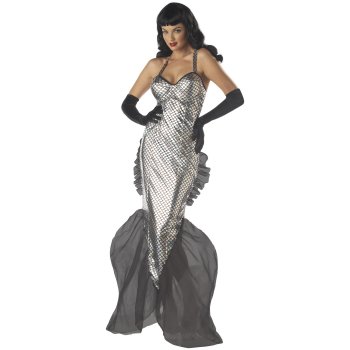
I do not own the gloves.
When skintight, long sleeve gloves help me dream of prosthetics.
The long-sleeve gloves I have are acrylic, fingerless; I wear them in cold circumstances when I need my fingers unencumbered to operate camera controls —though not to photograph myself in the dress in locations around the (small, local) world, something I did with trout some years ago, the gloves then latex to handle trout deteriorating well (accelerating rot, actually) on the third day of shooting.
While I did photograph trout on some old and some new Barbies (see more in forkergirl's Trout City flickr photo set):
I failed, and do regret now this failure that was something else then, to arrive at an obvious outcome of such mingling, the replacing of the trout head with a doll head, the exchange of Barbie bodies with trout filleted into skirt portions, allowing the Barbies to become better representatives, models for Mermaid Sisters, the story I wrote when I was seven. Something happened to them in the Greska of the Sea, called that so it couldn't possibly be real outside imagination where it was confined and further imagined with inescapable locks.
I do not think what happened was a trout brace or trout harness to hold them in on a couched roller coaster most Barbies didn't have when I played with them, no amusement park Barbie, the roller coaster cars flying off into ungrounded ambition as coaster did in Turn of the Screws,an episode of CSI. My cousin and I combined the Mystery Date board game and Clue into one mutation that let us scream, and everyone who heard me realized I was a fear-dependent first soprano who could put the fear of God to use: True Vine's junior choir, the robe white and shiny, glimmering like fish scales, though I looked more like an iced albatross singing.
Mine eyes have seen the glory, and now I've been struck blind in the left eye.

greška: croatian [We moved to a Coatian neighborhood when I was nine; it was no longer Coatian outside memory when I was fifteen]: defect, error, mistake.
illustration from Mermaid Sisters by forkergirl by another name at age seven. Greska appears twice as text, above and below the picture of Greska.
I own this dress
(available from, among many other places, awesome costume):

I do not own the gloves.
When skintight, long sleeve gloves help me dream of prosthetics.
The long-sleeve gloves I have are acrylic, fingerless; I wear them in cold circumstances when I need my fingers unencumbered to operate camera controls —though not to photograph myself in the dress in locations around the (small, local) world, something I did with trout some years ago, the gloves then latex to handle trout deteriorating well (accelerating rot, actually) on the third day of shooting.
While I did photograph trout on some old and some new Barbies (see more in forkergirl's Trout City flickr photo set):

I failed, and do regret now this failure that was something else then, to arrive at an obvious outcome of such mingling, the replacing of the trout head with a doll head, the exchange of Barbie bodies with trout filleted into skirt portions, allowing the Barbies to become better representatives, models for Mermaid Sisters, the story I wrote when I was seven. Something happened to them in the Greska of the Sea, called that so it couldn't possibly be real outside imagination where it was confined and further imagined with inescapable locks.
I do not think what happened was a trout brace or trout harness to hold them in on a couched roller coaster most Barbies didn't have when I played with them, no amusement park Barbie, the roller coaster cars flying off into ungrounded ambition as coaster did in Turn of the Screws,an episode of CSI. My cousin and I combined the Mystery Date board game and Clue into one mutation that let us scream, and everyone who heard me realized I was a fear-dependent first soprano who could put the fear of God to use: True Vine's junior choir, the robe white and shiny, glimmering like fish scales, though I looked more like an iced albatross singing.

greška: croatian [We moved to a Coatian neighborhood when I was nine; it was no longer Coatian outside memory when I was fifteen]: defect, error, mistake.
illustration from Mermaid Sisters by forkergirl by another name at age seven. Greska appears twice as text, above and below the picture of Greska.
Labels:
Barbie,
Bettie Page costume,
clue game,
dress-up,
forkergirl,
glove,
greska,
growing up,
limited fork theory story,
mermaid,
mystery date game,
photograph,
rules of inclusion,
trout
Wednesday, September 15, 2010
My research on Thailand
Mic says: One of the greatest differences between home and the USA is the cost!!

Monday, September 13, 2010
We get lost in a web of stories built tangentially off of each other until the origin, the spark of initial awareness, is gone: a math equation with missing parenthesis and brackets of closure. Seven seems to be the number repeating itself today, partially because I left "Seven" on repeat while I was baking cupcakes in the kitchen. It all seems to fit--creating new tines in the fork--from my story, to that of a seven year old imagining mermaids in the clouds, to my earlier thoughts of my cousin's seven year old daughter trying to process the death of her father in the heat of the Ohio summer. Something is feeding on my memory, causing me to scribble out strange Rules & Obstructions from the place where my brain cannot separate the senses. Synesthetics began the evening by tasting the muddled murmurs of the funerary feast; their stiffly pressed pant legs of coarse cotton clung to bruised kneecaps while rumpled handkerchiefs hung limply with discarded grief.
(a part of the story of the) MERMAID TINE
When I was seven, I was committed to compromise,
refusing to allow things to be only what they were,
a slave to metaphor.
No cloud was safe.
Anything I wanted to see
appeared above me in temporary galleries of icy sculpture.
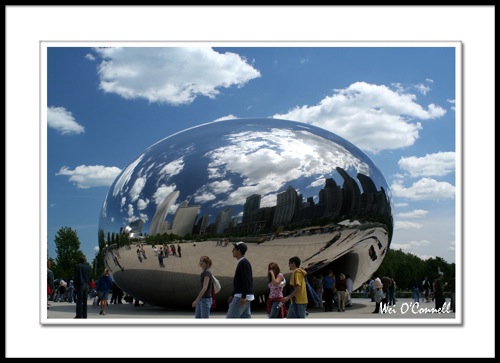 I have some co-conspirators:
I have some co-conspirators:
cloud-gate by Anish Kapoor in Millennium Park
where wei o-connell captured (for her cloud gate sculpture gallery
—please visit it) what I see, in this moment of seeing,
as a hatching of mermaid embryos in her image.
The embryos can also be(come) seeds of a need to impose such seeing, to grow such stories (high rises of stories, development after development, density and entanglement of of everything that can have a voice having its say, some of it through puppetry and ventriloquism and appropriation and hiccups)
without regard for possible benefit for humanity if telling alone lacks benefit,
proves nothing (assuming something in fact can be proved, proof that holds across
scale, across location, across durations of time).
Cloud Gate has a tine extension in Heathrow's Cloud by Troika:
A bit downtempo isn't it? Purpose or not, we're here, and we're made of our stories, our DNA telling a good one, full of recipe, prescription, destiny, opportunity for error, explanation, the joy of code, reduction to information, expansion to information, built-in script, and so forth. I'm trying to tell a story-tine about aspiration, always about aspiration, about becoming, a journey from one place to another, something even am amoeba can do, without requiring a way back, so as to keep nodding to how great it is to keep going, to church out whatever it is that inhabits the wake of movement, from gentle assistance to steamroller crush and pulverization into a fine power that travels the globe like all-purpose cosmetic.
Everything dressed up like mermaids.
Clouds of memories of mermaid parade.
Here is a forkergirl image of a cloud factory producing mermaid embryos:
 When I was seven, I wrote Mermaid Sisters and with my cousin made paper dolls that had a change of a dozen different fish tails, mostly based on what could be caught, including what we could imagine could be caught, in Lake Erie. We tried to carve mermaids out of ivory soap, but neither of us were good at that, some really bad butchering (nothing at all like what's available from The Mermaid Soap Company). It didn't occur to us to buy some mermaid soap molds, but we did pour Bosco chocolate syrup into small china lifeboats (from my aunt's good china set so seldom used, she didn't miss the shallow oval dishes just right for a Barbie or Tressy rescue in shallow water) that we put in the oven to try to bake chocolate bars.
When I was seven, I wrote Mermaid Sisters and with my cousin made paper dolls that had a change of a dozen different fish tails, mostly based on what could be caught, including what we could imagine could be caught, in Lake Erie. We tried to carve mermaids out of ivory soap, but neither of us were good at that, some really bad butchering (nothing at all like what's available from The Mermaid Soap Company). It didn't occur to us to buy some mermaid soap molds, but we did pour Bosco chocolate syrup into small china lifeboats (from my aunt's good china set so seldom used, she didn't miss the shallow oval dishes just right for a Barbie or Tressy rescue in shallow water) that we put in the oven to try to bake chocolate bars.  We also didn't have access to, and at that time couldn't imagine access to something that couldn't exist then (though a possible path to it was in progress): the wonderful Liana's Paper Doll Blog.
We also didn't have access to, and at that time couldn't imagine access to something that couldn't exist then (though a possible path to it was in progress): the wonderful Liana's Paper Doll Blog.
(image at left from Liana's Paper Doll Blog)
When we floated the mermaid paper dolls we drew, appropriately putting our half-fish in water, bending them so that their torsos were above water so that they could breathe without oxygen tanks, the paper outfits came off; those tabs we folded to hang the fish skirts onto the mermaids weren't secure fasteners.
The fish skirts floated separately.
Paper fish skirts and paper mermaids became increasingly fragile in the water.
They drank the water.
They became heavier with water. Soaked. Saturated.
 (image from animals in the attic.com)
(image from animals in the attic.com)
When we squeezed out the water, we held paper wads, the beginnings or aftermaths of paper wasp nests. It was as if we'd chewed and spit out deformed globes, very inexperienced makers of worlds yet the wads were habitable, could teem with microbes we didn't know anything about —and I had no excuse, having attended since kindergarten Louis Pasteur School, named for the then king of the war against germs harmful to humans, the source of the pasteurization process —pasteurized eggs among the safe eggs, the good eggs during the recent egg recall;
eggs that seem signed by Louis Pasteur himself. I do not know how Louis Pasteur felt about mermaids. Had he ever visualized his wife as a mermaid? Was there a mirror that gave her mermaid aspects of herself in exchange for reflection? I don't know how well mermaids may have engaged the imaginations or fever-sponsored realities of his children. I don't know what significance mermaids may have had for him or his children had typhoid not demanded their attention. I can speculate. I can give his children that succumbed to typhoid the gift of mermaid memory in the form of story I might make, some typhoid mermaid tines.
by Louis Pasteur himself. I do not know how Louis Pasteur felt about mermaids. Had he ever visualized his wife as a mermaid? Was there a mirror that gave her mermaid aspects of herself in exchange for reflection? I don't know how well mermaids may have engaged the imaginations or fever-sponsored realities of his children. I don't know what significance mermaids may have had for him or his children had typhoid not demanded their attention. I can speculate. I can give his children that succumbed to typhoid the gift of mermaid memory in the form of story I might make, some typhoid mermaid tines.
Writing this has given birth to the idea, has included typhoid mermaid tines into the multimedia story system, the limited forked consideration of mermaids that appeared to me in clouds over my head, sometimes taking on the weight of obligation, the fog of guilt for not acting on obligation.
Read Lois Pasteur's papers on Germ Theory
My search, at the moment, for mermaid in the Pasteur Galaxy did not produce any results, but try your own luck in the galaxy; try your own search. what cannot be found, cannot be pasteurized at this time, is not yet bug-free. At some point, a search for Pasteur and mermaid will lead here where the map is not yet reliable, where the meat of mermaid, typhoid, and Pasteur has not fully emerged, and in this gestation state is particularly susceptible to contamination, to mutation, perhaps on the order of trans-species work that may look more and more feasible, less and less ethical as it moves in a range of directions from trans-species organ transplantation. There is a place for this human/fish merger, even the reverse fish/human merge as in this work by Magritte: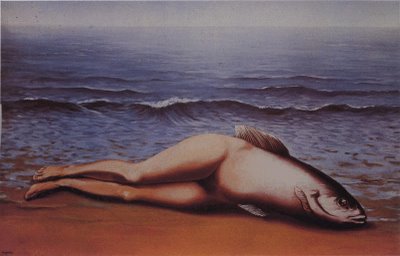 : Otherkin.net;
: Otherkin.net; 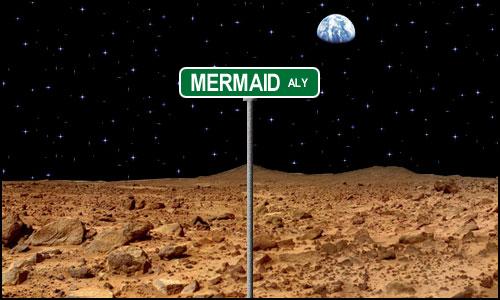 Otherkin.net is not the only place where species meet, where species have met, producing ligers and tigons, for instance; it's just one place, one tine of a story that in the telling nd retellings might be able to connect, however briefly, with everything on some scale in some location. Meet me at Mermaid Alley and form a
Otherkin.net is not the only place where species meet, where species have met, producing ligers and tigons, for instance; it's just one place, one tine of a story that in the telling nd retellings might be able to connect, however briefly, with everything on some scale in some location. Meet me at Mermaid Alley and form a (temporary) intersection.
refusing to allow things to be only what they were,
a slave to metaphor.
No cloud was safe.
Anything I wanted to see
appeared above me in temporary galleries of icy sculpture.
 I have some co-conspirators:
I have some co-conspirators:cloud-gate by Anish Kapoor in Millennium Park
where wei o-connell captured (for her cloud gate sculpture gallery
—please visit it) what I see, in this moment of seeing,
as a hatching of mermaid embryos in her image.
The embryos can also be(come) seeds of a need to impose such seeing, to grow such stories (high rises of stories, development after development, density and entanglement of of everything that can have a voice having its say, some of it through puppetry and ventriloquism and appropriation and hiccups)
without regard for possible benefit for humanity if telling alone lacks benefit,
proves nothing (assuming something in fact can be proved, proof that holds across
scale, across location, across durations of time).
Cloud Gate has a tine extension in Heathrow's Cloud by Troika:
A bit downtempo isn't it? Purpose or not, we're here, and we're made of our stories, our DNA telling a good one, full of recipe, prescription, destiny, opportunity for error, explanation, the joy of code, reduction to information, expansion to information, built-in script, and so forth. I'm trying to tell a story-tine about aspiration, always about aspiration, about becoming, a journey from one place to another, something even am amoeba can do, without requiring a way back, so as to keep nodding to how great it is to keep going, to church out whatever it is that inhabits the wake of movement, from gentle assistance to steamroller crush and pulverization into a fine power that travels the globe like all-purpose cosmetic.
Everything dressed up like mermaids.
Clouds of memories of mermaid parade.
Here is a forkergirl image of a cloud factory producing mermaid embryos:
 We also didn't have access to, and at that time couldn't imagine access to something that couldn't exist then (though a possible path to it was in progress): the wonderful Liana's Paper Doll Blog.
We also didn't have access to, and at that time couldn't imagine access to something that couldn't exist then (though a possible path to it was in progress): the wonderful Liana's Paper Doll Blog. (image at left from Liana's Paper Doll Blog)
When we floated the mermaid paper dolls we drew, appropriately putting our half-fish in water, bending them so that their torsos were above water so that they could breathe without oxygen tanks, the paper outfits came off; those tabs we folded to hang the fish skirts onto the mermaids weren't secure fasteners.
The fish skirts floated separately.
Paper fish skirts and paper mermaids became increasingly fragile in the water.
They drank the water.
They became heavier with water. Soaked. Saturated.
 (image from animals in the attic.com)
(image from animals in the attic.com) When we squeezed out the water, we held paper wads, the beginnings or aftermaths of paper wasp nests. It was as if we'd chewed and spit out deformed globes, very inexperienced makers of worlds yet the wads were habitable, could teem with microbes we didn't know anything about —and I had no excuse, having attended since kindergarten Louis Pasteur School, named for the then king of the war against germs harmful to humans, the source of the pasteurization process —pasteurized eggs among the safe eggs, the good eggs during the recent egg recall;
eggs that seem signed
 by Louis Pasteur himself. I do not know how Louis Pasteur felt about mermaids. Had he ever visualized his wife as a mermaid? Was there a mirror that gave her mermaid aspects of herself in exchange for reflection? I don't know how well mermaids may have engaged the imaginations or fever-sponsored realities of his children. I don't know what significance mermaids may have had for him or his children had typhoid not demanded their attention. I can speculate. I can give his children that succumbed to typhoid the gift of mermaid memory in the form of story I might make, some typhoid mermaid tines.
by Louis Pasteur himself. I do not know how Louis Pasteur felt about mermaids. Had he ever visualized his wife as a mermaid? Was there a mirror that gave her mermaid aspects of herself in exchange for reflection? I don't know how well mermaids may have engaged the imaginations or fever-sponsored realities of his children. I don't know what significance mermaids may have had for him or his children had typhoid not demanded their attention. I can speculate. I can give his children that succumbed to typhoid the gift of mermaid memory in the form of story I might make, some typhoid mermaid tines. Writing this has given birth to the idea, has included typhoid mermaid tines into the multimedia story system, the limited forked consideration of mermaids that appeared to me in clouds over my head, sometimes taking on the weight of obligation, the fog of guilt for not acting on obligation.
Read Lois Pasteur's papers on Germ Theory
My search, at the moment, for mermaid in the Pasteur Galaxy did not produce any results, but try your own luck in the galaxy; try your own search. what cannot be found, cannot be pasteurized at this time, is not yet bug-free. At some point, a search for Pasteur and mermaid will lead here where the map is not yet reliable, where the meat of mermaid, typhoid, and Pasteur has not fully emerged, and in this gestation state is particularly susceptible to contamination, to mutation, perhaps on the order of trans-species work that may look more and more feasible, less and less ethical as it moves in a range of directions from trans-species organ transplantation. There is a place for this human/fish merger, even the reverse fish/human merge as in this work by Magritte:
 : Otherkin.net;
: Otherkin.net;  Otherkin.net is not the only place where species meet, where species have met, producing ligers and tigons, for instance; it's just one place, one tine of a story that in the telling nd retellings might be able to connect, however briefly, with everything on some scale in some location. Meet me at Mermaid Alley and form a
Otherkin.net is not the only place where species meet, where species have met, producing ligers and tigons, for instance; it's just one place, one tine of a story that in the telling nd retellings might be able to connect, however briefly, with everything on some scale in some location. Meet me at Mermaid Alley and form a
Subscribe to:
Posts (Atom)



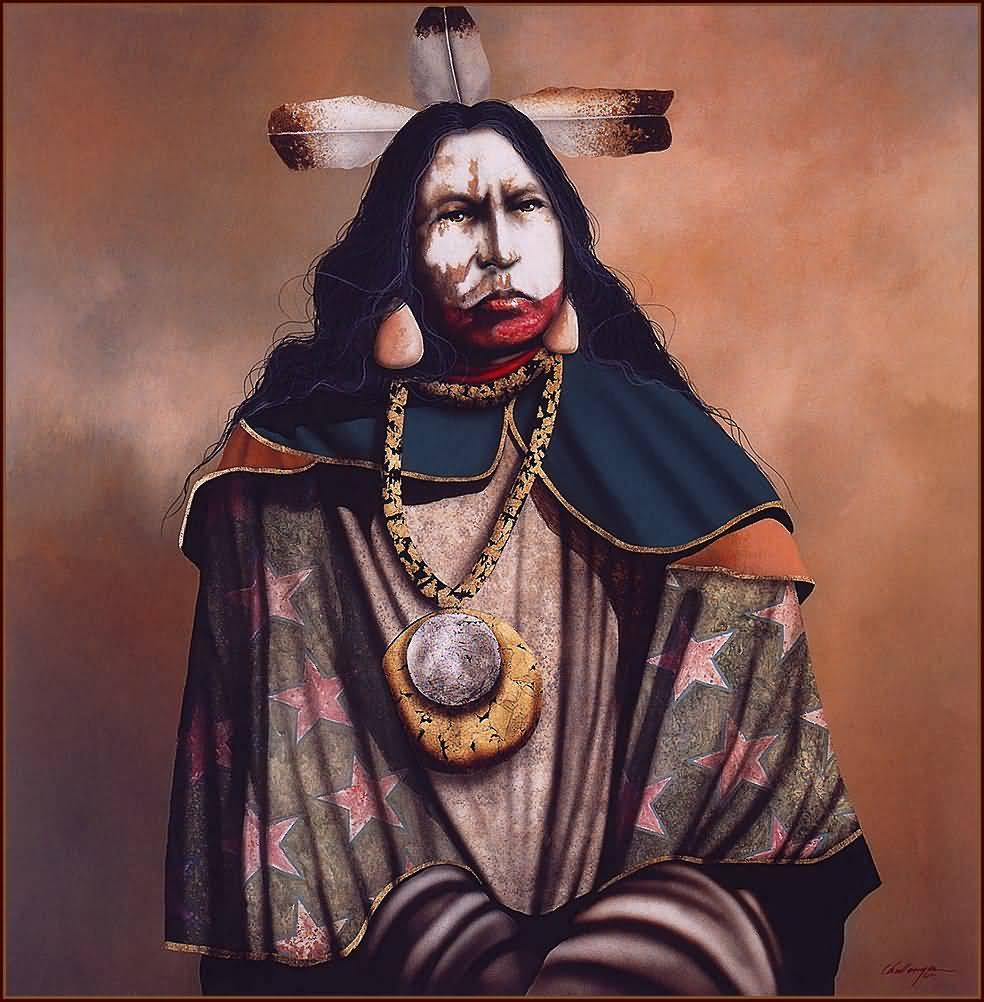 Reality
Reality